Molecular Dynamics Simulation of Single-Crystal 4H-SiC Nano Scratching with Different Scratching Directions of the Tool
Abstract
1. Introduction
2. Molecular Dynamics Simulation Modeling of 4H-SiC Single-Crystal Nano Scratches
3. The Effect of Tool Scratching Direction on Nanoscale Scratches in 4H-SiC Single Crystal
3.1. The Effect of Tool Scratching Direction on the Surface Morphology and Material Removel Rate of 4H-SiC Single Crystal
3.2. The Influence of Tool Scratching Direction on Material Surface Damage
3.3. The Influence of Tool Scratching Direction on Scratching Force
3.4. The Influence of Tool Scratching Direction on Temperature
4. Conclusions
- The removal form of 4H-SiC single crystal at the nanoscale is mainly amorphous chips, forming an amorphous machined surface. The scratching angle of the tool is different, and the stacking position of chip atoms is different. Chip atoms of 0° and 30° are stacked on one side of the tool edge, while chip atoms of 90° are stacked on both sides of the tool.
- When the scratching depth is small, the atoms of 4H-SiC single-crystal workpiece are mainly characterized by atomic defects and amorphous plastic deformation, and no dislocations are found on the subsurface of the workpiece. As the scratching depth increases, a large number of complete dislocations with a Burges vector of 1/3<110> appear on the subsurface of 4H-SiC single crystal, mainly extending on the (0001) plane, leading to the plastic removal of the material.
- Through the analysis of different scratching directions of the Berkovich indenter tool, it is found that a smaller rake angle not only reduces the scratching force during the scratching process, but also reduces the subsurface damage layer and workpiece temperature. The selection of scratching tools in the process of nano precision machining has certain significance.
Author Contributions
Funding
Institutional Review Board Statement
Informed Consent Statement
Data Availability Statement
Acknowledgments
Conflicts of Interest
References
- Liang, Y.C.; Li, Y.E.; Liu, Y.H.; Kuo, J.F.; Cheng, C.W.; Lee, A.C. High-quality structures on 4H-SiC fabricated by femtosecond laser LIPSS and chemical etching. Opt. Laser Technol. 2023, 163, 109437. [Google Scholar] [CrossRef]
- Wen, Q.; Yang, Y.; Lu, J.; Huang, H.; Cui, C. Study on picosecond laser stealth dicing of 4H-SiC along [1120] and [1100] crystal orientations on Si-face and C-face. Opt. Laser Technol. 2023, 162, 109300. [Google Scholar] [CrossRef]
- Sun, S.; Peng, X.; Xiang, H.; Huang, C.; Yang, B.; Gao, F.; Fu, T. Molecular dynamics simulation in single crystal 3C-SiC under nanoindentation: Formation of prismatic loops. Ceram. Int. 2017, 43, 16313–16318. [Google Scholar] [CrossRef]
- Jabbari, F.; Rajabpour, A.; Saedodin, S. Thermal conductivity and viscosity of nanofluids: A review of recent molecular dynamics studies. Chem. Eng. Sci. 2017, 174, 67–81. [Google Scholar] [CrossRef]
- Farajpour, A.; Ghayesh, M.H.; Farokhi, H. A review on the mechanics of nanostructures. Int. J. Eng. Sci. 2018, 133, 231–263. [Google Scholar] [CrossRef]
- Hollingsworth, S.A.; Dror, R.O. Molecular Dynamics Simulation for All. Neuron 2018, 99, 1129–1143. [Google Scholar] [CrossRef]
- Liu, X.; Shi, D.; Zhou, S.; Liu, H.; Liu, H.; Yao, X. Molecular dynamics simulations and novel drug discovery. Expert Opin. Drug Discov. 2018, 13, 23–37. [Google Scholar] [CrossRef]
- Wang, H.; Qu, Z.; Yin, Y.; Bai, J.; Yu, B. Review of Molecular Simulation Method for Gas Adsorption/desorption and Dif-fusion in Shale Matrix. J. Therm. Sci. 2018, 28, 1–16. [Google Scholar] [CrossRef]
- Venable, R.M.; Krämer, A.; Pastor, R.W. Molecular Dynamics Simulations of Membrane Permeability. Chem. Rev. 2019, 119, 5954–5997. [Google Scholar] [CrossRef] [PubMed]
- Zhou, Y.; Huang, Y.; Li, J.; Lv, W.; Zhu, F. Polishing process of 4H-SiC under different pressures in a water environment. Diam. Relat. Mater. 2023, 133, 109710. [Google Scholar] [CrossRef]
- Ito, H.; Kuwahara, T.; Kawaguchi, K.; Higuchi, Y.; Ozawa, N.; Kubo, M. Tight-binding quantum chemical molecular dynamics simulations for the elucidation of chemical reaction dynamics in SiC etching with SF6/O2 plasma. Phys. Chem. Chem. Phys. 2016, 18, 7808–7819. [Google Scholar] [CrossRef]
- Morishita, T.; Kayanuma, M.; Nakamura, T.; Kato, T. Cooperative Reaction of Hydrogen-Networked Water Molecules at the SiC–H2O2 Solution Interface: Microscopic Insights from Ab Initio Molecular Dynamics. J. Phys. Chem. 2022, 126, 12441–12449. [Google Scholar] [CrossRef]
- Rajendran, A.; Takahashi, Y.; Koyama, M.; Kubo, M.; Miyamoto, A. Tight-binding quantum chemical molecular dynamics simulation of mechano-chemical reactions during chemical–mechanical polishing process of SiO2 surface by CeO2 particle. Appl. Surf. Sci. 2005, 244, 34–38. [Google Scholar] [CrossRef]
- Noreyan, A.; Amar, J. Molecular dynamics simulations of nanoscratching of 3C SiC. Wear 2008, 265, 956–962. [Google Scholar] [CrossRef]
- Goel, S.; Luo, X.; Agrawal, A.; Reuben, R.L. Diamond machining of silicon: A review of advances in molecular dynamics simulation. Int. J. Mach. Tools Manuf. 2015, 88, 131–164. [Google Scholar] [CrossRef]
- Goel, S.; Luo, X.; Reuben, R.L.; Rashid, W.B. Atomistic aspects of ductile responses of cubic silicon carbide during nanometric cutting. Nanoscale Res. Lett. 2011, 6, 589. [Google Scholar] [CrossRef]
- Goel, S.; Luo, X.; Reuben, R.L. Molecular dynamics simulation model for the quantitative assessment of tool wear during single point diamond turning of cubic silicon carbide. Comput. Mater. Sci. 2012, 51, 402–408. [Google Scholar] [CrossRef]
- Goel, S.; Luo, X.; Reuben, R.L. Shear instability of nanocrystalline silicon carbide during nanometric cutting. Appl. Phys. Lett. 2012, 100, 231902. [Google Scholar] [CrossRef]
- Luo, X.; Goel, S.; Reuben, R.L. A quantitative assessment of nanometric machinability of major polytypes of single crystal silicon carbide. J. Eur. Ceram. Soc. 2012, 32, 3423–3434. [Google Scholar] [CrossRef]
- Goel, S.; Stukowski, A.; Luo, X.; Agrawal, A.; Reuben, R.L. Anisotropy of single-crystal 3C–SiC during nanometric cutting. Model. Simul. Mater. Sci. Eng. 2013, 21, 065004. [Google Scholar] [CrossRef]
- Xiao, G.; To, S.; Zhang, G. Molecular dynamics modelling of brittle–ductile cutting mode transition: Case study on silicon carbide. Int. J. Mach. Tools Manuf. 2015, 88, 214–222. [Google Scholar] [CrossRef]
- Xiao, G.; To, S.; Zhang, G. The mechanism of ductile deformation in ductile regime machining of 6H SiC. Comput. Mater. Sci. 2015, 98, 178–188. [Google Scholar] [CrossRef]
- Hanashiro, T.; Saitoh, K.I.; Sato, T.; Nishimura, K.; Takuma, M.; Takahashi, Y. Molecular Dynamics Study on Ductile Behavior of SiC during Nanoindentation. Tribol. Online 2016, 11, 183–188. [Google Scholar] [CrossRef]
- Zhu, B.; Zhao, D.; Tian, Y.; Wang, S.; Zhao, H.; Zhang, J. Study on the deformation mechanism of spherical diamond indenter and its influence on 3C-SiC sample during nanoindentation process via molecular dynamics simulation. Mater. Sci. Semicond. Process. 2019, 90, 143–150. [Google Scholar] [CrossRef]
- Zhu, B.; Zhao, D.; Zhao, H. A study of deformation behavior and phase transformation in 4H-SiC during nanoinden-tation process via molecular dynamics simulation. Ceram. Int. 2019, 45, 5150–5157. [Google Scholar] [CrossRef]
- Meng, B.; Yuan, D.; Xu, S. Study on strain rate and heat effect on the removal mechanism of SiC during nano-scratching process by molecular dynamics simulation. Int. J. Mech. Sci. 2019, 151, 724–732. [Google Scholar] [CrossRef]
- Meng, B.; Yuan, D.; Xu, S. Coupling effect on the removal mechanism and surface/subsurface characteristics of SiC during grinding process at the nanoscale. Ceram. Int. 2019, 45, 2483–2491. [Google Scholar] [CrossRef]
- Meng, B.; Yuan, D.; Xu, S. Atomic-Scale Characterization of Slip Deformation and Nanometric Machinability of Sin-gle-Crystal 6H-SiC. Nanoscale Res. Lett. 2019, 14, 309. [Google Scholar] [CrossRef] [PubMed]
- Meng, B.; Yuan, D.; Zheng, J.; Xu, S. Molecular dynamics study on femtosecond laser aided machining of monocrystalline silicon carbide. Mater. Sci. Semicond. Process. 2019, 101, 1–9. [Google Scholar] [CrossRef]
- Liu, Y.; Li, B.; Kong, L. Molecular dynamics simulation of silicon carbide nanoscale material removal behavior. Ceram. Int. 2018, 44, 11910–11913. [Google Scholar] [CrossRef]
- Tian, Z.; Xu, X.; Jiang, F.; Lu, J.; Luo, Q.; Lin, J. Study on nanomechanical properties of 4H-SiC and 6H-SiC by molecular dynamics simulations. Ceram. Int. 2019, 45, 21998–22006. [Google Scholar] [CrossRef]
- Zhou, P.; Shi, X.; Li, J.; Sun, T.; Zhu, Y.; Wang, Z.; Chen, J. Molecular dynamics simulation of SiC removal mechanism in a fixed abrasive polishing process. Ceram. Int. 2019, 45, 14614–14624. [Google Scholar] [CrossRef]
- Zhao, L.; Alam, M.; Zhang, J.; Janisch, R.; Hartmaier, A. Amorphization-governed elasto-plastic deformation under nanoindentation in cubic (3C) silicon carbide. Ceram. Int. 2020, 46, 12470–12479. [Google Scholar] [CrossRef]
- Sarikov, A.; Marzegalli, A.; Barbisan, L.; Scalise, E.; Montalenti, F.; Miglio, L. Molecular dynamics simulations of extended defects and their evolution in 3C–SiC by different potentials. Model. Simul. Mater. Sci. Eng. 2020, 28, 015002. [Google Scholar] [CrossRef]
- Nosé, S. A unified formulation of the constant temperature molecular dynamics methods. J. Chem. Phys. 1984, 81, 511–519. [Google Scholar] [CrossRef]
- Hoover, W.G. Canonical dynamics: Equilibrium phase-space distributions. Phys. Rev. A 1985, 31, 1695–1697. [Google Scholar] [CrossRef] [PubMed]
- Erhart, P.; Able, K. Analytical potential for atomistic simulations of silicon, carbon, and silicon carbide. Phys. Rev. B 2005, 71, 035211. [Google Scholar] [CrossRef]
- Chai, P.; Li, S.; Li, Y.; Yin, X. Study on Damage of 4H-SiC Single Crystal through Indentation and Scratch Testing in Micro–Nano Scales. Appl. Sci. 2020, 10, 5944. [Google Scholar] [CrossRef]
- Wu, Z.; Zhang, L.; Liu, W. Structural anisotropy effect on the nanoscratching of monocrystalline 6H-silicon carbide. Wear 2021, 476, 203677. [Google Scholar] [CrossRef]
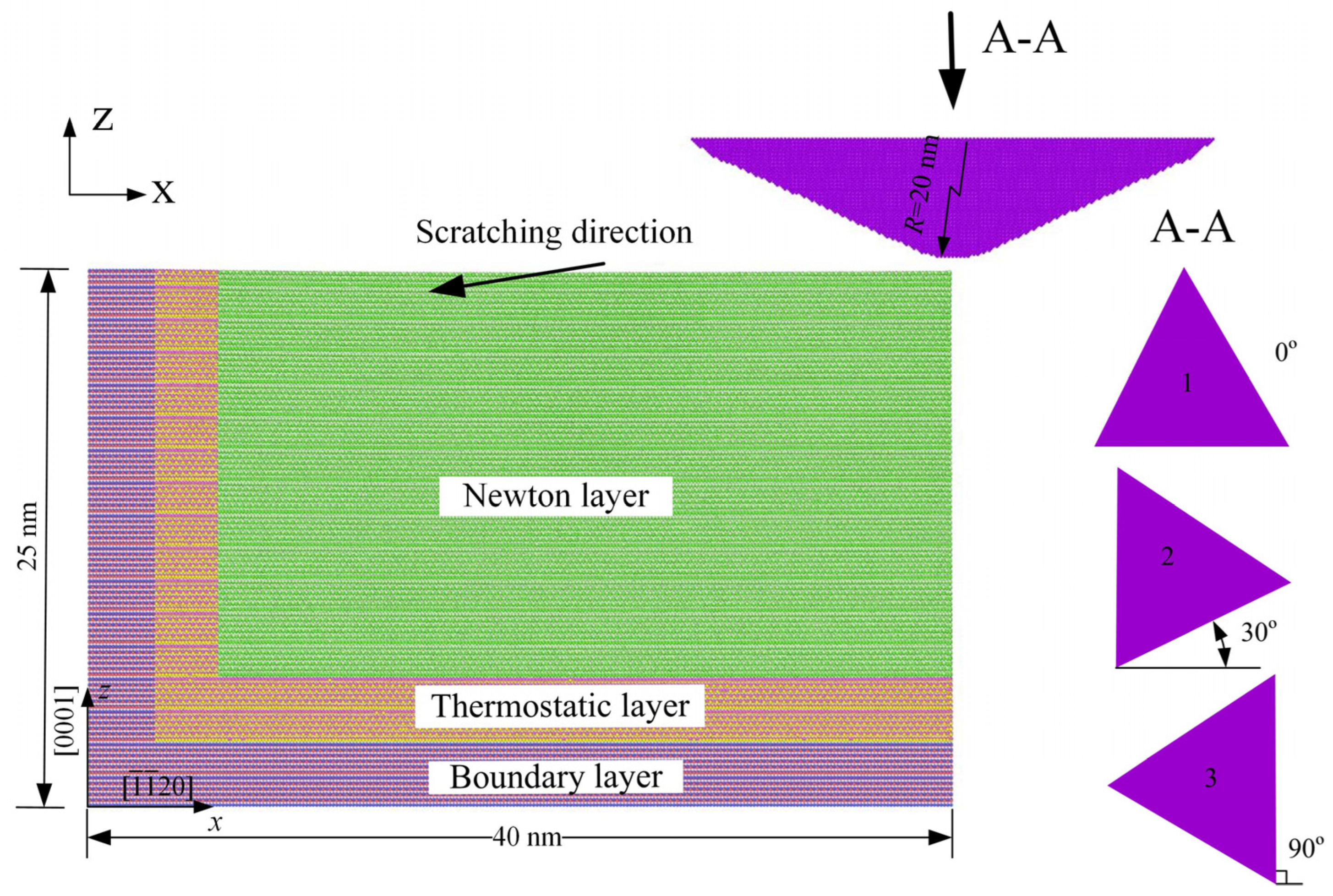
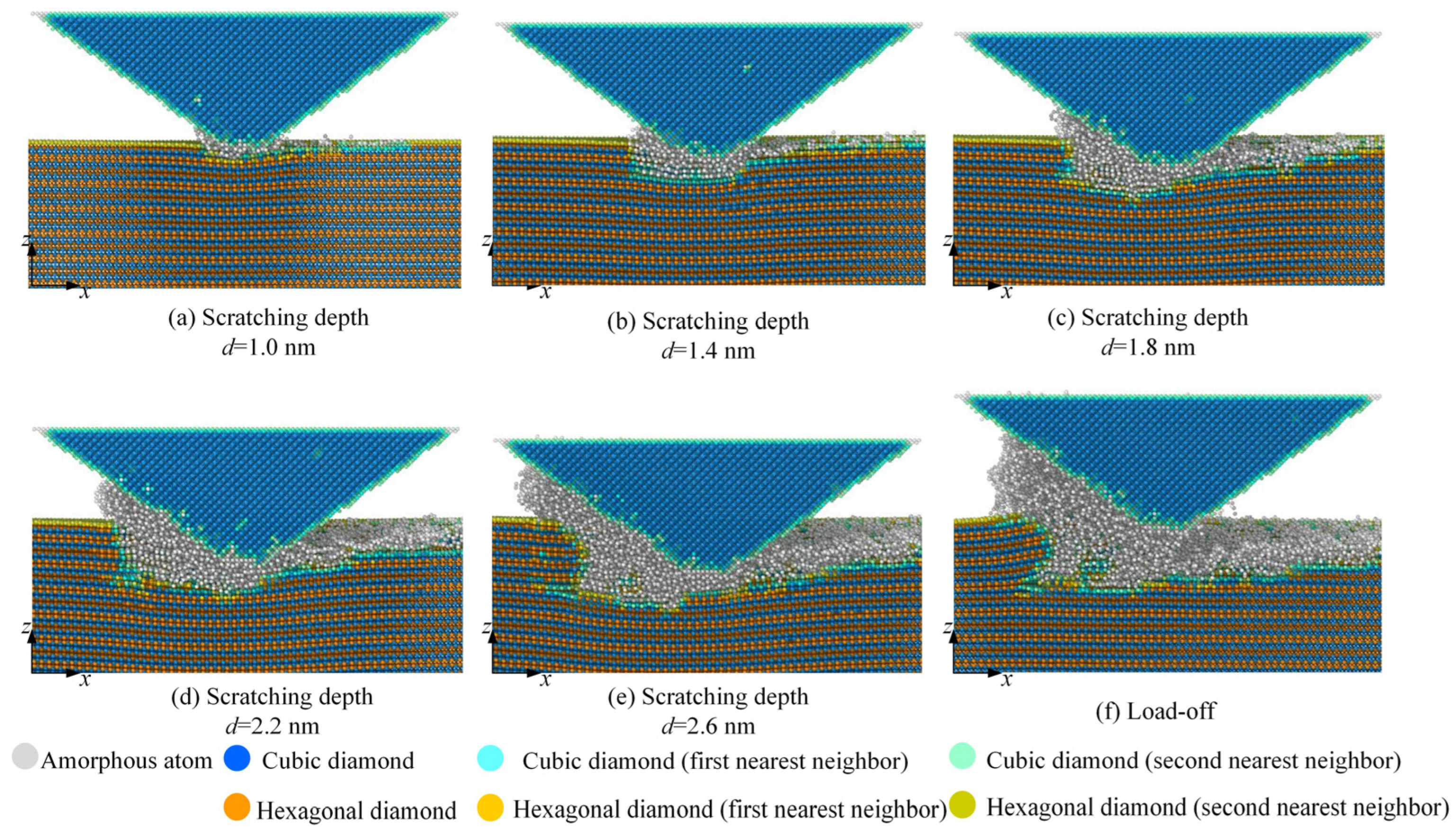
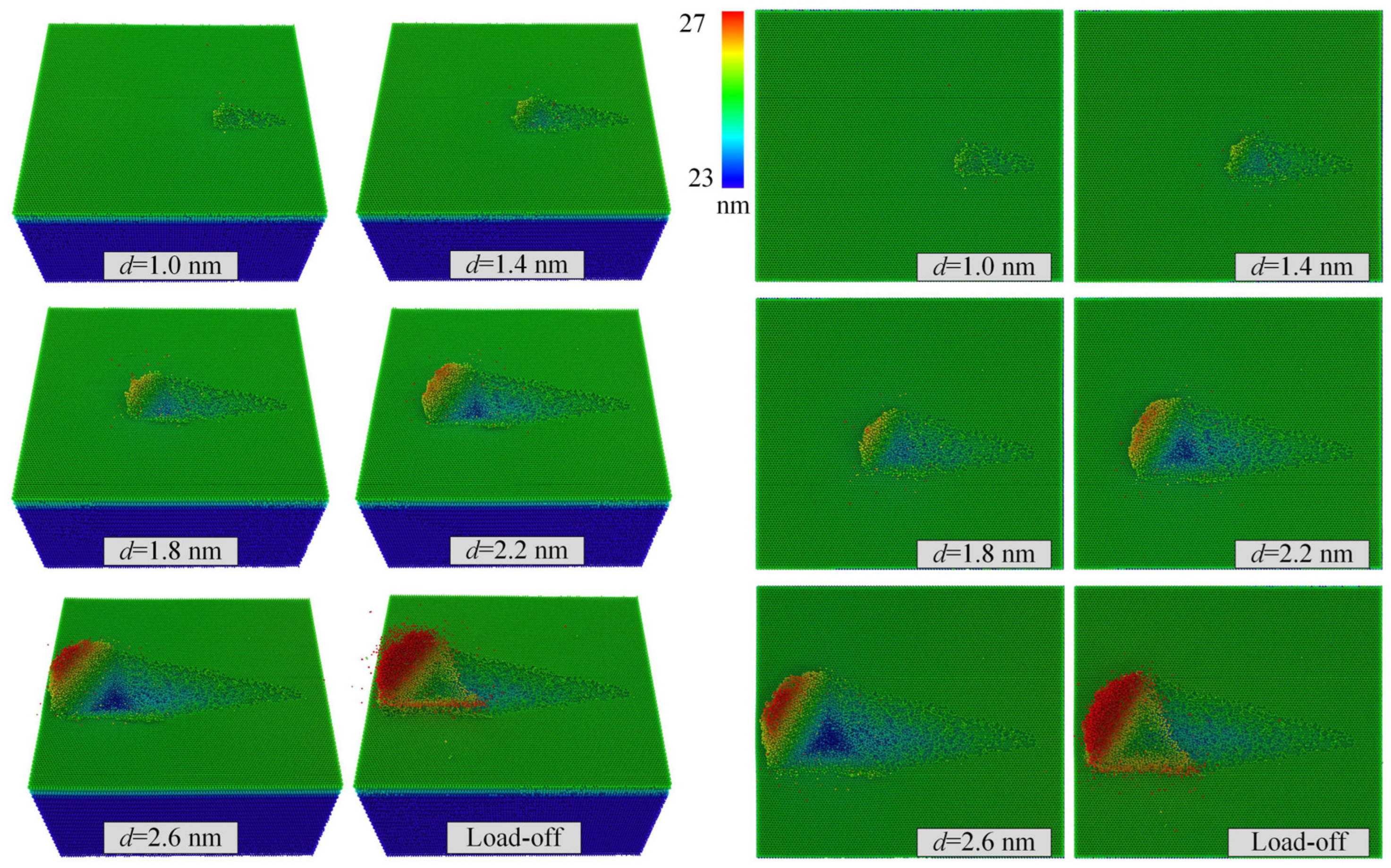
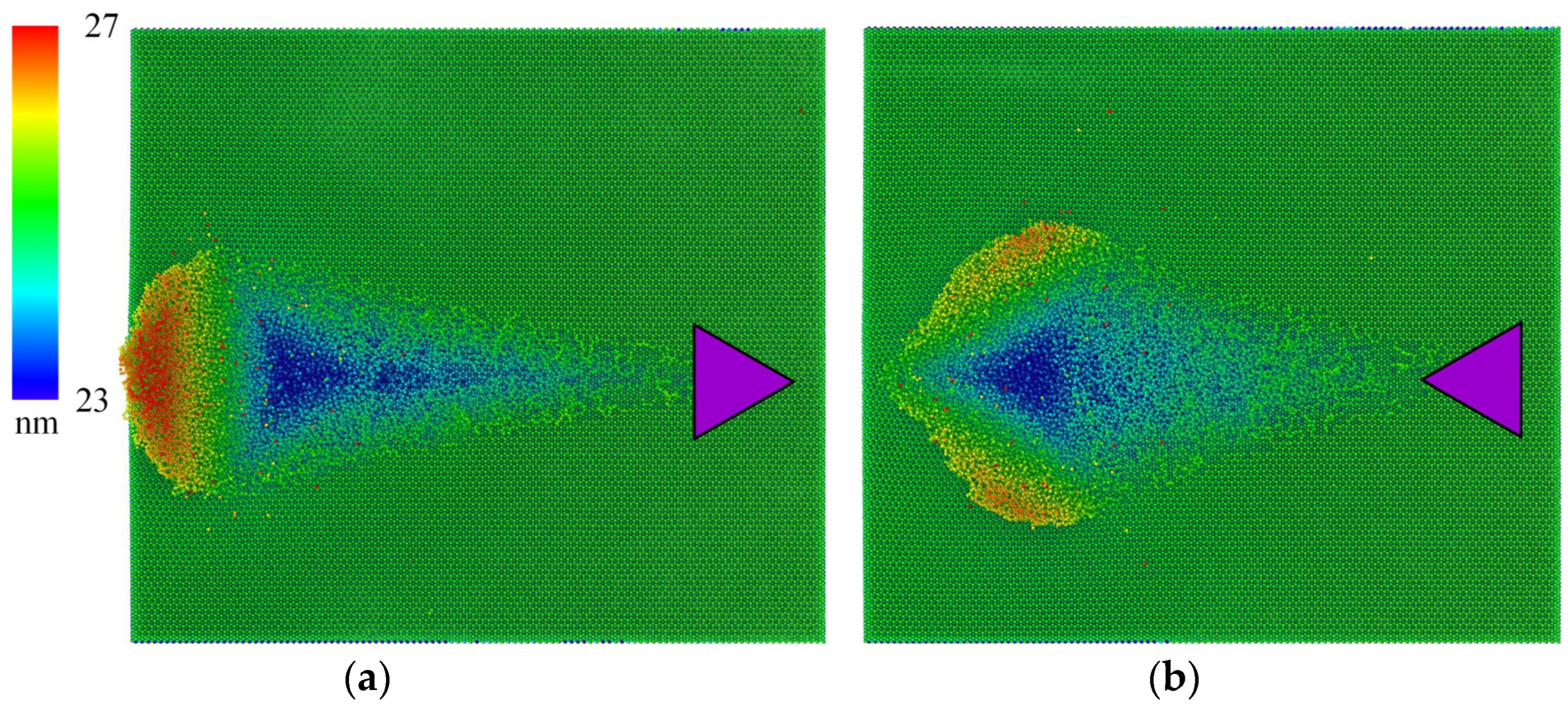


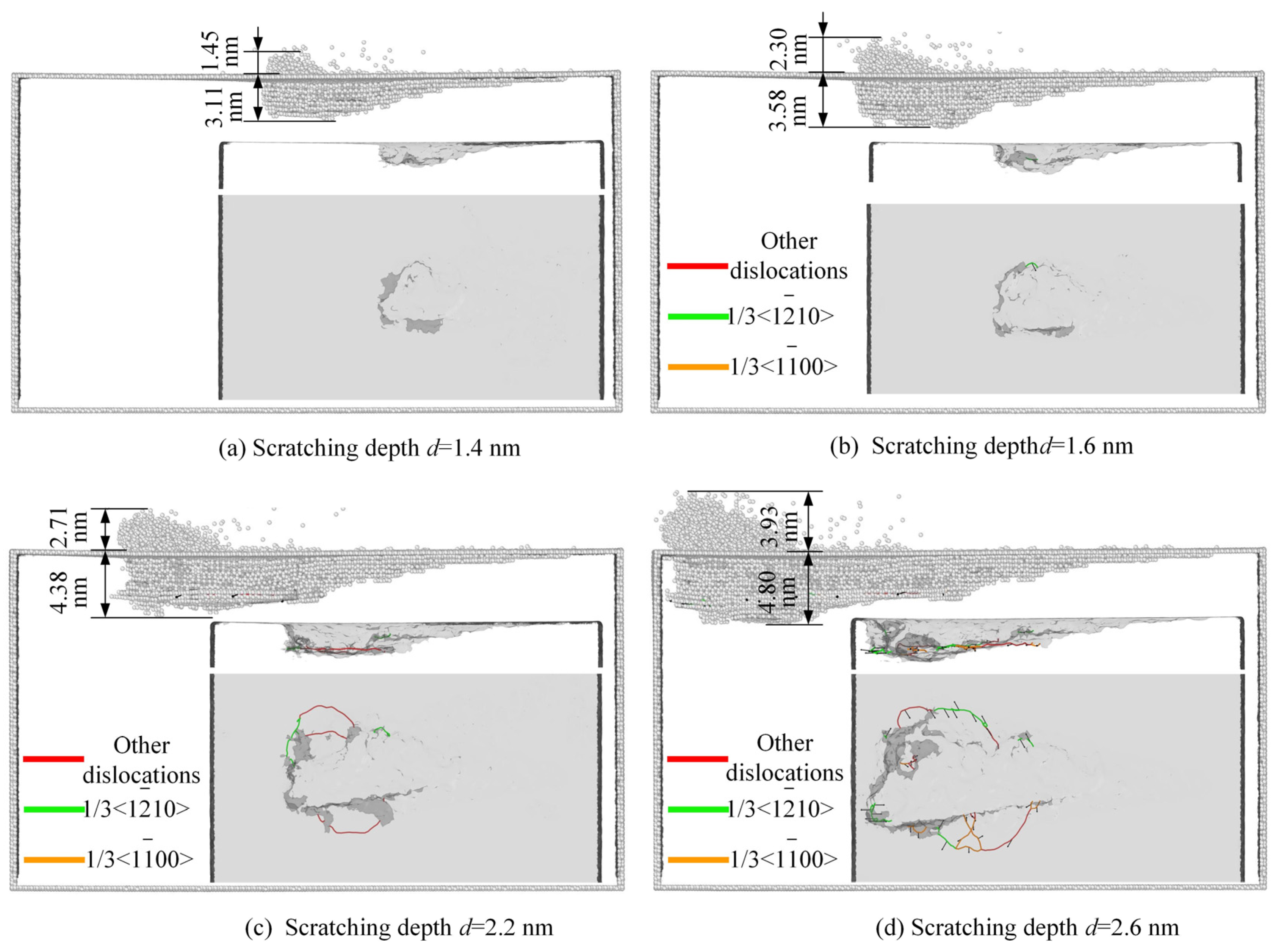
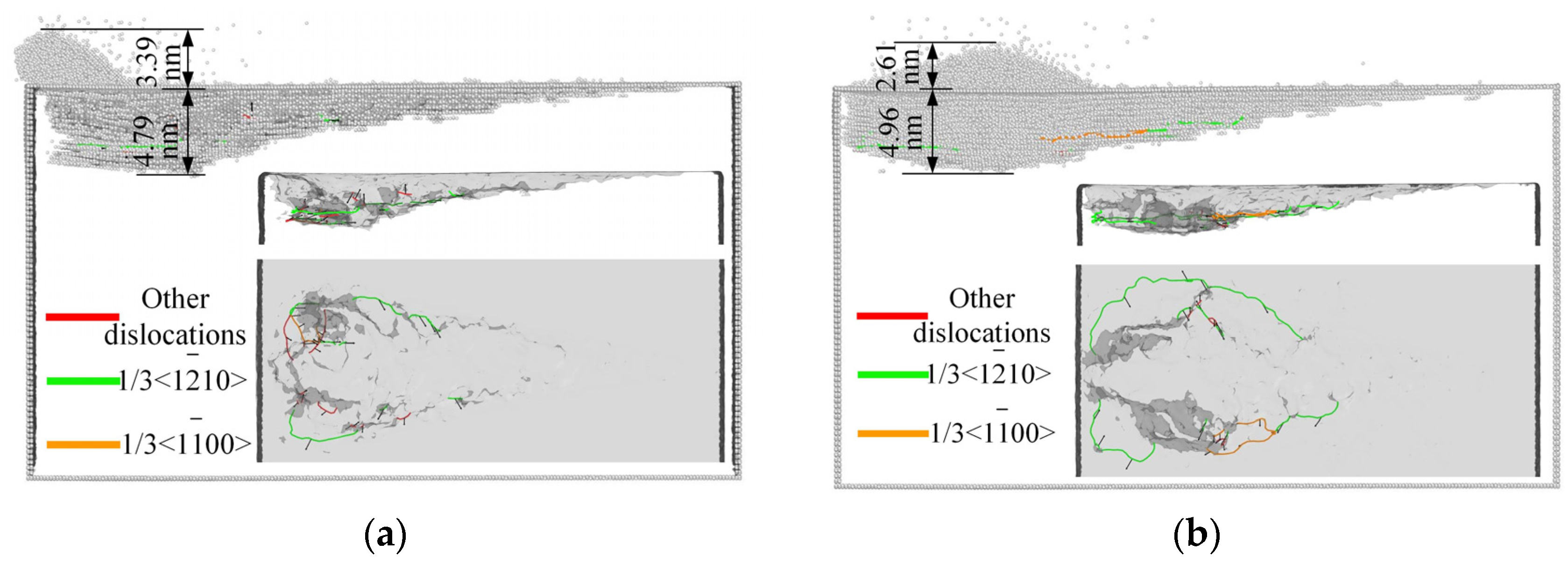

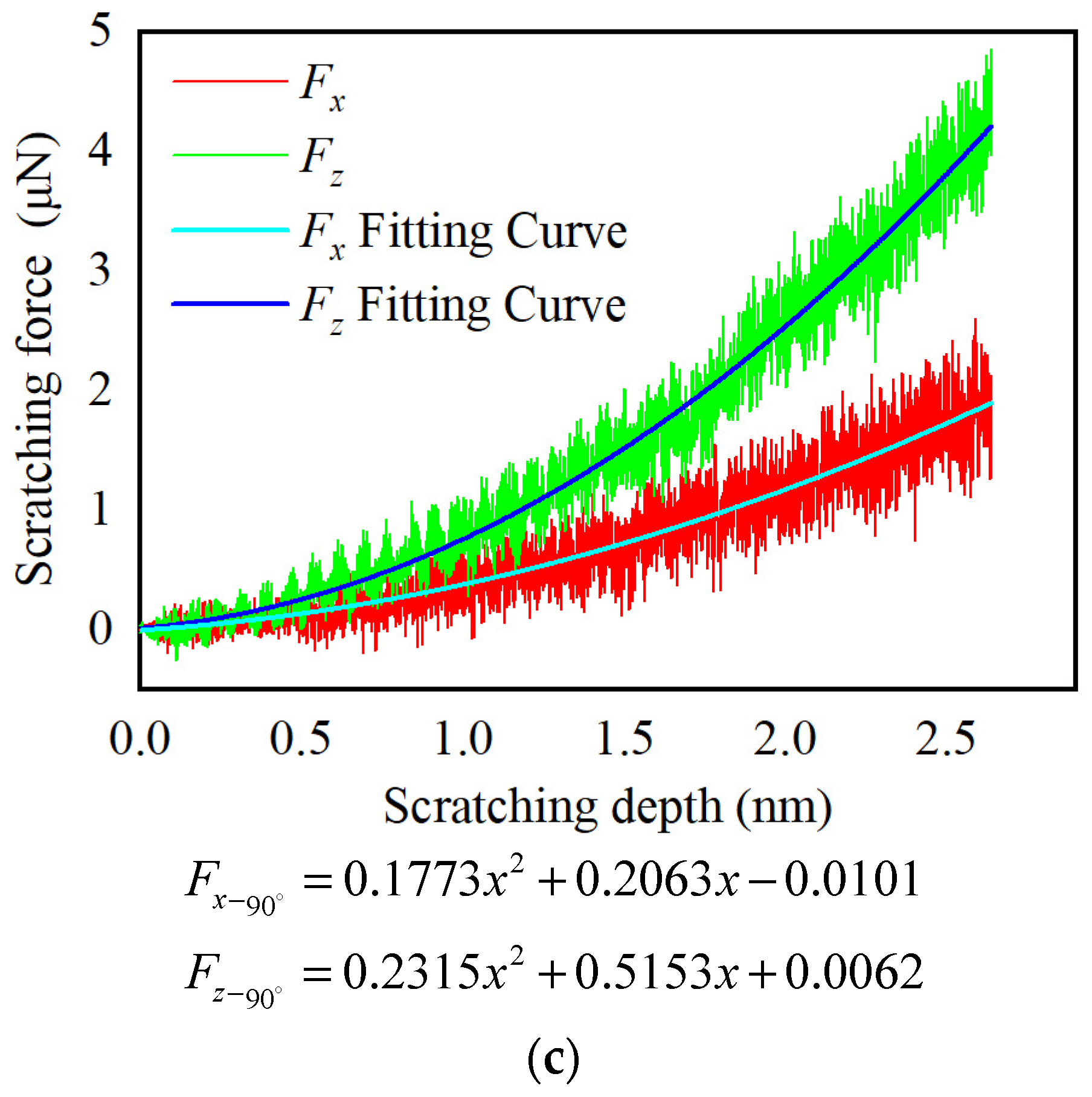

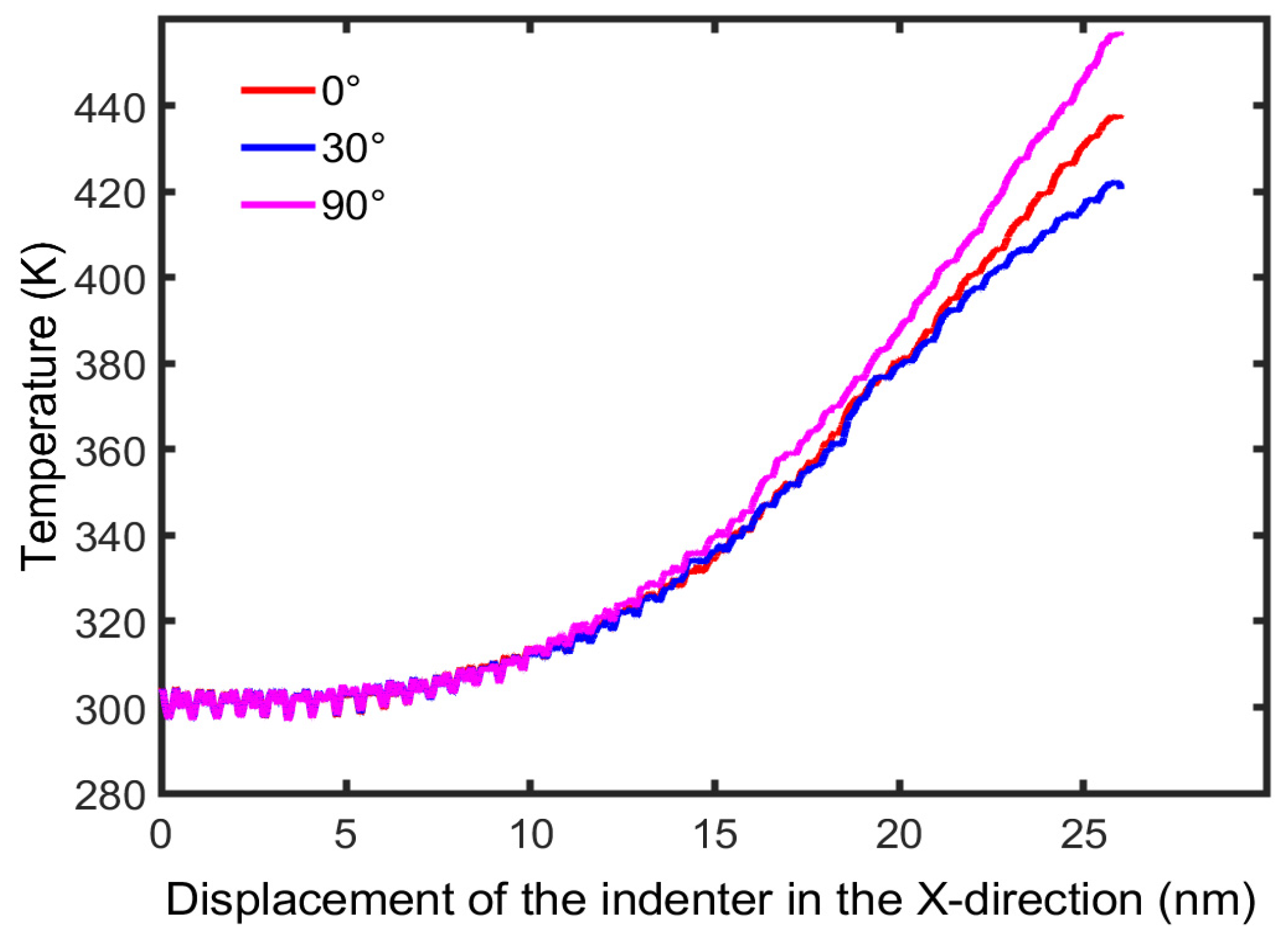
| Scratching Direction of the Tool | 0° | 30° | 90° |
|---|---|---|---|
| Vertical view | 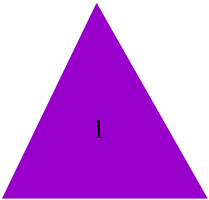 |  | 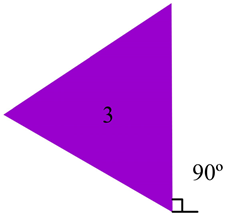 |
| Front view |  |  |  |
| Rake angle α | 75.15° | 65.3° | 77.05° |
| Parameter | Si-Si | C-C | Si-C |
|---|---|---|---|
| D0 (eV) | 3.24 | 6.00 | 4.36 |
| r0 (Å) | 2.222 | 1.4276 | 1.79 |
| S | 1.570 | 2.167 | 1.847 |
| 1.4760 | 2.0099 | 1.6991 | |
| γ | 0.09253 | 0.11233 | 0.011877 |
| c | 1.13681 | 181.910 | 273,987 |
| d | 0.63397 | 6.28433 | 180.314 |
| h | 0.335 | 0.5556 | 0.68 |
| 0 | 0 | 0 | |
| R (Å) | 2.9 | 2 | 2.4 |
| D (Å) | 0.15 | 0.15 | 0.2 |
Disclaimer/Publisher’s Note: The statements, opinions and data contained in all publications are solely those of the individual author(s) and contributor(s) and not of MDPI and/or the editor(s). MDPI and/or the editor(s) disclaim responsibility for any injury to people or property resulting from any ideas, methods, instructions or products referred to in the content. |
© 2023 by the authors. Licensee MDPI, Basel, Switzerland. This article is an open access article distributed under the terms and conditions of the Creative Commons Attribution (CC BY) license (https://creativecommons.org/licenses/by/4.0/).
Share and Cite
Liang, L.; Li, S.; Chai, P.; Lan, K.; Yu, R. Molecular Dynamics Simulation of Single-Crystal 4H-SiC Nano Scratching with Different Scratching Directions of the Tool. Crystals 2023, 13, 1044. https://doi.org/10.3390/cryst13071044
Liang L, Li S, Chai P, Lan K, Yu R. Molecular Dynamics Simulation of Single-Crystal 4H-SiC Nano Scratching with Different Scratching Directions of the Tool. Crystals. 2023; 13(7):1044. https://doi.org/10.3390/cryst13071044
Chicago/Turabian StyleLiang, Lie, Shujuan Li, Peng Chai, Kehao Lan, and Ruijiang Yu. 2023. "Molecular Dynamics Simulation of Single-Crystal 4H-SiC Nano Scratching with Different Scratching Directions of the Tool" Crystals 13, no. 7: 1044. https://doi.org/10.3390/cryst13071044
APA StyleLiang, L., Li, S., Chai, P., Lan, K., & Yu, R. (2023). Molecular Dynamics Simulation of Single-Crystal 4H-SiC Nano Scratching with Different Scratching Directions of the Tool. Crystals, 13(7), 1044. https://doi.org/10.3390/cryst13071044






